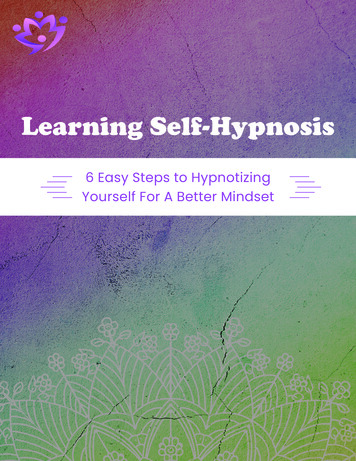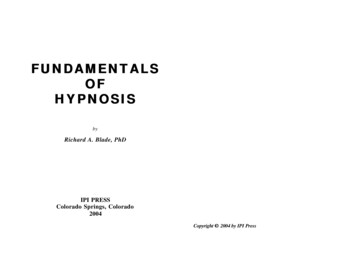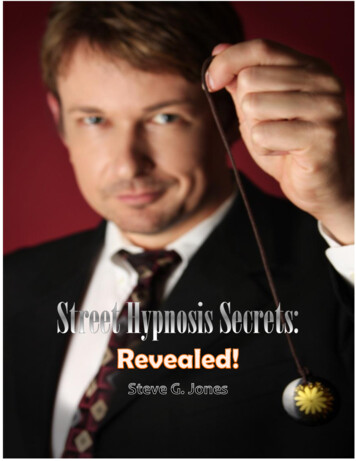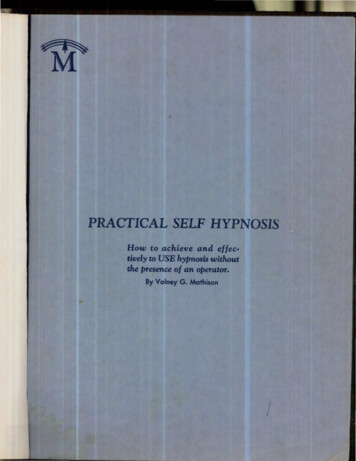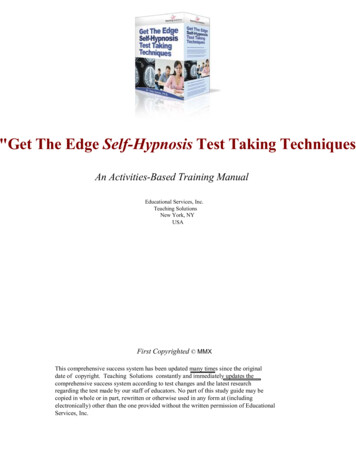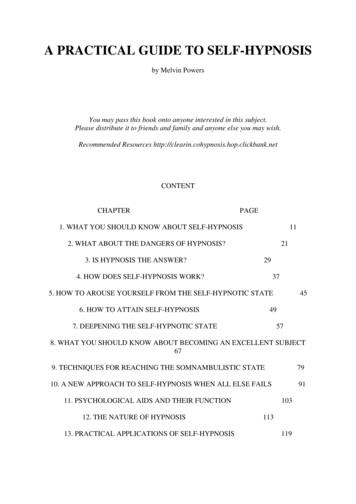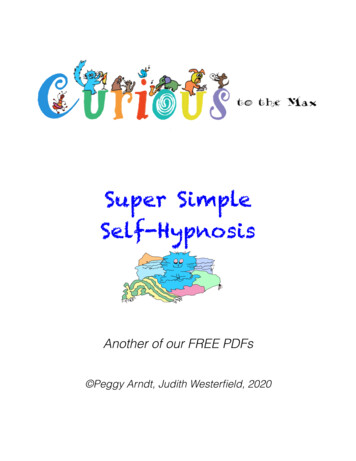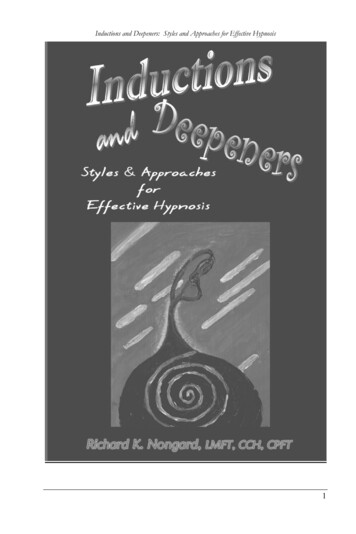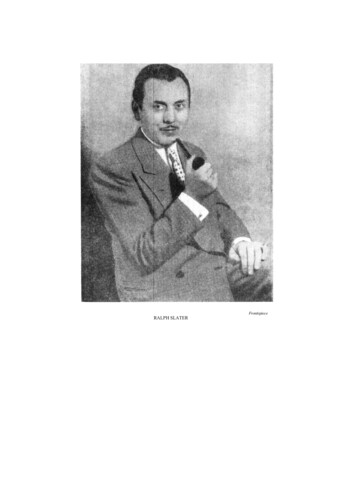
Transcription
RALPH SLATERFrontispiece
HYPNOTISMANDSELF-HYPNOSISbyRALPH SLATERGERALD DUCKWORTH & CO. LTD3 HENRIETTA ST., LONDON, W.C.2Distributed byWILSH1RE BOOK CO1324 Wilshire Boulevard, Los Angeles, California
First published May 1950Reprinted 1951 (twice) 1952, 1955 and 1956All rights reservedBrought to you byhttp://www.HypnoticInstantProfits.comVisit the site to claim yourFREE Self Hypnosis Mp3PRINTED INGREAT BRITAIN BYW1LLMERBROTHERS AND CO., LTD., BIRKENHEAD
DEDICATIONI DEDICATE this work to all those who, throughout my publiccareer, have so graciously consented to volunteer as subjects forhypnotism during my public demonstrations; also to the membersof the medical profession, young and old, who have helped makethe book possible.I wish at the same time to extend my sincerest thanks to all thoseeditors and newspapermen who personally gave me so much helpand encouragement during my 1949 tour: among them:Ralph Champion (Sunday Pictorial)A. Coulter (News Review)Jack Fishman (Sunday Empire News)Arthur Helliwell (The People)Prof. C. E. M. Joad (Sunday Dispatch)Cyril Kersh (The People)Bob Musel (United Press)Rex North (Sunday Pictorial)Dick Richards (Sunday Pictorial)Bill Richardson (Evening Standard)Thomas Richardson (The Times)Arnold Russell (Reynolds News)George Scott (Daily Express)Hannen Swaffer (The People)
CONTENTSPART IINTRODUCTORYI. THE HISTORY OF HYPNOTISM5II. THIS MODERN WORLD8III .PSYCHOLOGISTS AND PSYCHIATRISTS11IV. ABOUT MYSELF14P ART IIHOW TO HYPNOTISEV. METHODS OF HYPNOTISM2OVI. DANGERS OF HYPNOTISM36VII. HOW TO AWAKEN THE SUBJECT41VIII. POST-HYPNOTIC SUGGESTION45IX. STAGES OF HYPNOTISM48X. SELF-HYPNOSIS OR AUTO-SUGGESTION52XL HYPNOTHERAPY58XII. THE TEN CARDINAL POINTS78
PART ICHAPTER ONEThe History of HypnotismH YPNOTISM is by no means a new art. True, it hasbeen developed into a science in comparatively recentyears. But the principles of thought control have beenused for thousands of years in India, ancient Egypt,among the Persians, Chinese and in many other ancientlands. Miracles of healing by the spoken word andlaying on of hands are recorded in many early writings.The priests and medicine men of primitive tribes usedthese forces widely and still use them to-day, withresults sufficiently impressive to maintain their traditional position of authority for successive generations.The father of modern hypnotism was Mesmer, anative of Vienna, who moved to Paris in 1778, andattracted a large following through reports of thousandsof cures. Like many pioneers, the theory which headvanced to explain his work was later discredited.This was called animal magnetism. He believed that amagnetic fluid flowed from the operator to the patientwhich contained miraculous healing power. Thosewho followed Mesmer proved conclusively that therewas no such magnetic current, but that the force whichoperated was in reality mental suggestion. Mesmer,who was a good showman, also made extensive useof passes and gestures, and of complicated apparatusmade up of magnetic wires and rods, quite useless,of course, except as a way of impressing a gulliblepatient.5
6HYPNOTISM AND SELF-HYPNOSISDr. James Braid, born in Manchester in 1795, after muchexperimentation, discarded the theory of Mesmer, provingthat the same results could be obtained without Mesmer'sballyhoo, and without any belief in animal magnetism. Atfirst Braid used no verbal suggestion in putting his patients tosleep, merely having them gaze at a bright object, held a fewinches above their eyes, until they became drowsy and fellinto a deep sleep, in which they responded to his commands.In his later practice he added suggestion to this physicalmeans of hypnosis with much more excellent results. Braidwas the first to use the word hypnotism, coined from theGreek word hypnos meaning sleep.The science of hypnotism was further developed by thework of Doctors Liebault, Bernheim and Charcot some yearslater in France. Liebault, while using the Braid method ofinducing sleep, made much more extensive use of suggestion;he was remarkable in that he practised for twenty years as apoor doctor in a remote country village, always refusingpayment for his hypnotic services. Bernheim, at first a critic,later a friend and student of Liebault, organised the science ofsuggestive therapy into a complete system of treatment.While Bernheim and Liebault in the Nancy School, whichthey founded together, worked almost exclusively withhealthy and normal people, whom they found to be the mostsatisfactory subjects, Charcot, who founded the Paris School,had his successes mainly with nervous and neurotic patients,who flocked to him in great numbers, and he accepted it ashis mission to help these unfortunate people. As a neurologistand an expert in hysteria, Charcot disagreed violently withBernheim's view that hypnotism worked on the mind of the patient,
THE HISTORY OF HYPNOTISM7and always claimed hypnotism as a neurological ratherthan a psychological technique.Outstanding among the scientists in America whohave influenced the development of hypnotism wereProfessor William James, Dr. Boris Sidis and G.Stanley Hall. These thinkers developed the concept ofthe subconscious mind in explaining the phenomena ofhypnotic suggestion. They taught that in hypnotism,the conscious mind of the subject was placed in a stateof inaction or suspension, and that the operator wasconsequently able to direct his suggestions or commandsdirectly to the subconscious.The great Viennese psychologist, Sigmund Freud,began his career as an admirer of Bernheim and adevotee of hypnotism, but later came to believe that thetechnique placed the doctor too much in the positionof a dictator to his patient, and preferred his ownmilder psychoanalytical method of "free association",the details of which need not concern us here. I needonly remark that the speed of hypnotism gives itcertain advantages over the slower processes ofpsychoanalysis, especially where, as for example in anarmy hospital in wartime, a large number of patientsrequire treatment at once and the pressure of work isreally high.What these scientists have done for tens of thousands,through the years of the development of the hypnoticart, is being actively accomplished to-day. In the secondpart of this book I describe in detail the methods whichhave been used to bring better health, happiness andsuccess to the vast number of modern patients who haveenjoyed the benefits of hypnosis.
CHAPTER TWOThis Modern WorldIT is a strange world we live in. To me nothing isstranger than the immense part played in oureveryday lives by the power of suggestion. The veryhighly organised industries of advertising andsalesmanship are typical instances of this. Forexample, two large rival chemical combines areselling rival brands of aspirin. Their products arealmost identical—they have to conform to theminimum chemical standards prescribed by law. Yetall day long we see advertised all round us "BuyXYZ Aspirin—there is no better", and next time webuy aspirin, chances are we insist on XYZ brand,because it is easy to ask for, and we cannotremember any other brand at the moment.Given this power of suggestion on the human mind at allhours of the waking day, it is horrifying to me how seldomthe power is consciously used for good, and how ournewspaper editors, film makers and others catering for publicentertainment seem almost to rejoice in spotlighting the uglieraspects of life. "I have supped full with horrors", says Hamlet,and the modern man would merely have to alter this to "Ihave breakfasted full with horrors", after reading his dailymorning newspaper. Floods, earthquakes, air crashes,murders, divorces and suicides are certain of their place in theheadlines; while a new advance in public health, or theopening of a new playing-field which will give pleasure tothousands is lucky if it qualifies for two inches at the8
THIS MODERN WORLD9bottom of the page. How often we are shown the photoof a man who has recently fallen dead in the street fromheart attack; how seldom the photo of a man who gotover a heart attack ten years ago, and now enjoys hisSaturday game of golf like anyone else!I have long maintained, in public and in private, thatparticularly in the health sphere—a subject in whichmost people are personally interested—this concentration on disaster does an untold amount of unseen harm.I regard heart disease, cancer, and fear of insanity as thethree great killers of the world to-day. All three arecomplaints the mere whisper of which may make a mandie mentally twenty-five years before he dies physically.No other complaints induce that paralysing fear of thefuture which, as every doctor knows, is itself enough toprevent any cure or possibility of arresting the diseaseif it in fact has got a hold on a patient. Even in tuberculosis it can be clearly demonstrated to the patientwhether or not he has the disease; and even cripples,and the blind or deaf learn to adjust themselves to theirdisabilities, for they know they are going to live.Do you remember that old story of the Traveller andthe Plague? On his way one day the Traveller met amysterious, cloaked figure hurrying along in the opposite direction, and stopped to ask him who he was."I am the Plague," came the reply, "going along to thetown you've just passed to kill 100,000 people there.At least I myself shall only kill 200. Fear will do therest for me. Good morning."So when the ordinary man reads about death, disease,and disasters day after day in his newspapers; when hislocal cinema runs film after film about life in a lunaticasylum or the activities of paranoiac gunmen; when, as
10HYPNOTISM AND SELF-HYPNOSISrecently in the U.S.A., he couldn't drive his car to thenext town without seeing huge hoardings along theroads shouting at him to beware of cancer (which hewould never otherwise have given a thought to)—howcan we doubt that a vast amount of unnecessary andeasily preventable sickness is caused by the power of awrong idea to establish itself inside the human mind?And how can we doubt the desperate need in thismodern world for a technique which can help to expelsuch ideas once they become established? Hypnotismis such a technique.
CHAPTER THREEPsychologists and PsychiatristsALL over the world the dominating power of the humanmind over the human body is steadily being recognised.I have always wished to use the word "superconscious"instead of the more common subconscious, as I believe"superconscious" better expresses this idea of domination, the full extent of which is even now not sufficientlyunderstood. I would like to see the thousands ofpounds now spent on research into treating the symptoms of disease spent instead on further research intothese fascinating and all-important matters.How many of the general public, for example, knowthat there are two different kinds of perspiration: onephysical—when we sweat after violent physical exercisein hot weather—and one nervous, when we sweat withfear or excitement? These two perspirations showcompletely different reactions to the appropriate chemical tests. The first kind is not under the control of themind, the second is.How many of the general public realise that underhypnosis it can be suggested to a subject that he is eatingfood, so that his gastric juices are stimulated and hisintestinal reactions can be shown to be exactly the sameas though he was eating a good meal, although not acrumb has in fact passed his lips?How many members of the general public know thatobstinate and long-standing warts and blisters havebeen removed gradually by suggestion under hypnosis,11
12HYPNOTISM AND SELF-HYPNOSISand that other physical changes in the skin surface canbe induced in the same way? That heart and pulsebeats can be raised and lowered in the same way?How many members of the general public realisefully the psychological factors involved in stomachulcers, hyper-acidity and the many other internal disorders in which the mind and emotions of the suffererhave taken complete charge of his heart, liver, pancreasor lungs—the normal action of which is entirely involuntary? Isn't it this extraordinary ability of the mindto effect changes in the organic tissue of the body whichparticularly needs research?I do not think the public have much idea of thesethings, though the rise of psychoanalysts and otherpractitioners who concentrate on the mind factor is awelcome sign; and I myself am often asked by ordinarypeople for my advice about them.I regard hypnotism as the tool of psychiatry, perhaps the best tool it has. I claim personally to havehypnotised more men and women than any man living,and my work—especially my experience in U.S. Armyand Navy hospitals during the recent war—has shownme what a wonderful tool it can be, in what a vastvariety of different cases; so that I say boldly hypnotismshould be within the power of every medical manmaking any claim to eminence in the psychiatric field.It is little use for a doctor to ask questions about thecolour of your grandmother's underwear, whether youever remember falling out of your perambulator, andother questions about things past and forgotten (andoften better forgotten too) if he cannot do somethingpractical to offer you hope for your present and future.Therefore I would say there are three qualities that
PSYCHOLOGISTS AND PSYCHIATRISTS13every good psychiatrist must have—and indeed everygood doctor, whether psychiatrist or general practitioner,knows from his own experience the value of thesepoints:(i) He must be a good listener. He must realisethat his patients are mostly lonely people bursting to pour out their woes to him, and find inhim that pillar of sympathy and friendlinesswhich we all of us need so much,(ii) He must be a direct talker and not wrap up hisopinions in incomprehensible jargon. "Youhave a chronic inferiority complex" sounds unnecessarily damning to any patient; "you arerather a shy sort of chap" says the same thingmuch better.(iii) He must be a man of the widest possible experience and understanding. There is nothing soheartening to a patient as to hear his doctor say:"Well, you're not the only one, you know; I hadthis trouble and got over it after a bit, andlook at me now! We'll fix it for you."I am not myself a deeply religious man, but I cannothelp seeing that in the modern world the psychoanalyst hasto some extent replaced the priest—except perhaps in theRoman Catholic church, which in its ritual of confessionand absolution still makes official provision for that deepseated human desire to "get things off one's chest". Thepsychoanalyst, therefore, has responsibilities as seriousas the priest. Let him discharge them in the same spirit ofgravity and humility, in the knowledge that the materialpassing through his hands is that most precious, delicateand wonderful of all created things—the human mind.
CHAPTER FOURAbout MyselfTHIS is the least valuable chapter in the book, and may beskipped by all those who are interested in hypnotism fromthe professional point of view. As I have often explained,there is nothing personal to me in my methods of hypnotism,and the technique generally has nothing to do with thepersonality or the character of the hypnotist. Given thenecessary self-confidence, hypnotism and self-hypnotismcan be taught to all and sundry. It is like swimming: oncetake the first plunge and the rest is easy.Some people, however, are always interested in "how itall began", and since most of my ideas are naturally theresult of my parentage, environment and upbringing, I givethe following few facts about myself.I am the eldest of six children. My childhood in UpperClapton, then one of the pleasanter suburbs in London, wasnot a particularly happy one. My father, who was a verywealthy man, gave me every opportunity for education, butbecause of his tremendous interest in my mother and in hisvery successful business life, he did not give me the thing Ineeded most—understanding. I was always alone and wasconsidered by my family as a strange boy who refused totake advantage of his parents' desires to see him as a greatsurgeon or successful business man, and who instead spentmost of his time reading books on psychology and thescience of the mind, which, to my14
ABOUT MYSELF15parents, made me a "hopeless case", destined to cometo no good.It had been one of our neighbours in Clapton—aretired writer in the late seventies, who first influencedme towards the study of psychology. When I was onlytwelve he lent me my first books on the science of themind, which has been my preoccupation ever since.He remained for many years my friend and when, atabout the age of twenty, I left for America to seek myfortune there, I still continued to correspond with himon the subjects which interested us both.At this time it was my father's idea I should train tobe a surgeon, while my mother, who was very muchunder the spell of the famous violinist Mischa Elman'splaying, was determined I should be a violinist. I tooka few lessons but couldn't make a go of it, although Ihave remained interested in music ever since. At thatage I was a bit of a rebel against my parents anyway—most young men are—and after my very casual and haphazard upbringing it would have been a miracle if I hadsettled easily to anything. For many years in AmericaI was just too busy trying to survive to study anythingor immerse myself in anything seriously. I took variousjobs—radio announcer, actor (for one day only), composer of light music and assistant to a man on an ice-cart.(This last job didn't last long, since I weighed only 90lbs. at the time and was called on to lift blocks of iceso much heavier than myself that I collapsed one day.)Then I began to practise on a few of my friends theideas about hypnotism that had been simmering in mymind all these long years. I was determined for a startto eliminate 95 per cent of all the vast accumulation ofstuff I had read on the subject. No nonsense about soft
l6HYPNOTISM AND SELF-HYPNOSISlights and sweet music for me. I wished to perfect atechnique of double-quick hypnotism, so I couldhypnotise a patient in about the time it takes a doctorto give an injection, or less if possible. And as Ibelieved in myself this was indeed the technique I perfected and have since demonstrated on the stage ofmany theatres on both sides of the Atlantic.I gave my first public demonstration to a restrictedgroup of five physicians. Among the group was afamous New York doctor, who was at once tremendously impressed by what he saw. He took me asideafterwards to give me some advice. "Young man," hesaid, "I have been greatly interested by your performance; but you understand that if I was to proclaimpublicly my belief in your methods, my official doctors'association would step on me like a cockroach, andprobably on you too. The thing for you to do is to goout into the world and make a big name for yourselfwith the public. Remember that when you're downstairs shouting up, no one hears you; when you areupstairs shouting down, they all hear you—and comeback to ask for more."So I took this doctor's advice and he gave me duringall my early years as a hypnotist his constant help andsupport for nothing. I said to myself, "Well, why notstart at the top, if it's the top we're aiming at?"—andthough I had to beg and borrow the money, I took NewYork's huge Carnegie Hall one night and gave there ademonstration to a selected audience—all guests personally invited by me—including 1500 doctors and disabled servicemen. Later I played Carnegie Hall seventimes in one year, and I am the only man in the worldto have done that.
ABOUT MYSELF17On one of these occasions I found myself billed nextto Mischa Elman, who had appeared there just beforeme. You may be sure that I had the notices photographed and sent a copy to my mother in England whohad been so keen for me to follow Elman's steps as aviolinist!You can imagine too the great feeling of satisfactionwhich it gave me, on my return to Britain in 1949 as astar, to see my mother and father proudly stand up andtake bows at every opening night, whether it was in atheatre or an auditorium like the Empress Hall, Earl'sCourt, where I set a new precedent by appearing "solo"at this huge arena for an entire week, with no otherscenery but twelve chairs.People often ask me why I appear in theatres. Thereare two answers: (1) that desire for security whichinfluences us all in more or less degree, and (2) thefeeling that I have a definite mission to interest thepublic, and especially the informed medical public, inthe vast possibilities of hypnotism. During the recentwar I spent practically all my time in U.S. Army andNavy camps working on disabled men and givingdemonstrations to groups of doctors. For this all I haveto show is a series of beautiful diplomas. One cannotunfortunately pay one's rent with beautiful diplomas.Again, I know that a theatrical performance is thequickest, most dramatic way of demonstrating my burning faith in the curative power of hypnotism. There areby now thousands of people in Great Britain—peoplewho would otherwise have dismissed hypnotism, if theythought of it at all, as unreliable black magic—who haveseen such "miracles" as this happening before their owneyes on the brightly lit stage of a public theatre:
18HYPNOTISM AND SELF-HYPNOSIS(i) a cripple walking with a stick, who had to behelped up the stairs on to the stage by others, leave thesame stage walking steadily and proudly under hisown steam. (I still have that stick, which he leftwith me as a souvenir!)(ii) a confirmed chain-smoker (60 cigarettes a day)throw away two cigarettes running with every sign ofdisgust immediately after the first puff, after I hadgiven him post-hypnotic suggestion to this effect.(iii) an old man shaking all over with some functionalnervous disorder, who was regarded by himself andothers as unemployable and had drawn a war-disabilitypension for years at his country's expense, stand upstraight and strong again like the fine young soldier heonce had been,(iv) a well-known journalist stretched stiff like a boardbetween two chairs—head on one chair heels on anotherand nothing between—so that I myself could take mystand on him, and he could bear my whole weight on hisunsupported stomach with ease. (See illustration.)All these things were unrehearsed by-products of myordinary stage show; for when at each performance I call forvolunteers to come up on the stage, I have no way of tellingwhat sort of people will come—and they are a mixed lot,believe me! Such "miracles", then, have been witnessed bythousands—general public, medical men and newspapermenalike—and it is only natural that these many thousands will bewondering to themselves, in sickness and in health, how canhypnotism help ME? It is to try and satisfy this very naturalcuriosity that I have written this book.
PART IICHAPTER FIVEMethods of Hypnotism(including the Ralph Slater Method)I SHOULD like to begin this chapter on methods ofhypnotising by making clear a few very importantpoints. What I am about to say now may surprise thereader, but the hypnotist actually does not hypnotisethe subject; the subject hypnotises himself. The hypnotistmerely acts as the instrument through whom the suggestions for sleep are given. With this thought in mind,it can be readily understood that the first law ofhypnotism is to make the subject believe that he is goingto be hypnotised. This is achieved by the manner andbearing of the hypnotist, who, by his very actions andconfidence, impresses the subject with his ability tohypnotise him. Therefore, the hypnotist must havecomplete confidence in his ability to hypnotise anynormal person. If this sense of confidence is ever relaxed so as to admit the slightest doubt, he may fail.Do not be discouraged if you do not succeed in hypnotising the first few people upon whom you experiment.Once you have hypnotised successfully, you willundoubtedly gain the confidence that is necessary tomake you an expert hypnotist. I mention this point inmy first paragraph, and wish to dwell on it, since Ibelieve the lack of this necessary confidence to be onereason why hypnotism is so comparatively little usedtherapeutically to-day. Such20
Plant! Niws Ltd.RALPH SLATER DEMONSTRATES "CATALEPSY"—STANDS ON BODY OFHYPNOTISED JOURNALIST AS DOCTORS AND NEWSPAPERMEN LOOK ONI feel that for a few more years at least I must consolidate the little bit of reputation I now have andbuild up a position for myself in which I shall be freeto forget my own troubles, and set to work relievingsome of the pain and misery we see about us in theworld. I already have plans for clinics where I canteach my methods personally, but it takes time toorganise things just how I want them.In another book one day I shall describe my earlyadventures more fully; but every author should be prepared to come forward and take his bow before hispublic, and I hope that I have done so well enough inthis chapter, for those who are interested.
METHODS OF HYPNOTISM21confidence is in no way peculiar to me, or a mysteriouspart of the Ralph Slater method, but just one of thosebasic rules of life. In this world other people accept youat your own valuation of yourself; thus it is your firstduty to desire sincerely to help your subject, and yoursecond to make your subject realise that this is yourdesire.Of course, most ordinary practising doctors arealready certain enough of their ability to relieve suffering, and they are already accustomed to taking responsibility often at the shortest notice, and issuingclear-cut orders for the good of their patients. This isall in the day's work, and such men will already have thefundamental confidence to embark without hesitation,and with complete success on the regular practice ofhypnotism, which may become, as I suggest elsewhere,the most useful weapon in their whole armoury ofhealing. But there is no reason why medical studentstoo, though they are young and have less experience ofthe rough and tumble of a doctor's daily life, should notbecome proficient hypnotists. Indeed, as in most otherspheres of life, the young have the immense advantageof youth and energy over their elders, and the acquiringof this technique early on in life will enable the youngdoctor to bring his skill to greater heights of perfectionthan his seniors can hope to.I have seen cases where several people in a row havefailed to respond to hypnotism; and by the same token,where thirty or forty people consecutively can be placedin a state of deep hypnosis without any difficulty whatsoever. All disturbing elements must be removed.When you practise hypnotism, try to do so in anenvironment which is conducive to the concentration
22HYPNOTISM AND SELF-HYPNOSISof your subject. Avoid draughts. A draught will sometimes keep a subject awake, where he normally wouldfall asleep. Also, distracting noises should be so far aspossible avoided.Some subjects, who cannot be hypnotised at the firstattempt, will fall into a hypnotic state after two or threetries. I would strongly recommend that for his initialattempts at hypnotism, the operator should practise onstrangers instead of on his friends, because the psychological effect is so much greater. Someone who knowsthe hypnotist too intimately might not fall into thepassive state of mind which is necessary for hypnosis.I cannot stress too strongly the importance of readingeach chapter over and over until the reader has thoroughlyacquainted himself with every detail. The confidencegained by his thorough study of this book will enablethe hypnotist to be much more successful. And nowfor some of the methods of hypnotism.THE BRAID METHODAs indicated in the first lesson, Dr. Braid, who gavehypnotism its name, used the method of focusingthe attention of the subject on some mechanical object,held a few inches above the eyes; so as to create anoptical strain, which would aid in making the eyelidsheavy, and in inducing the hypnotic sleep. This methodis still used by some practitioners. The main objectionis that it requires considerable time, usually from sixto twelve minutes, and the strain on the eyes mightpossibly give the subject a slight headache. The directsuggestive method seems equally effective, and is muchquicker. I have demonstrated in my radio programmes,and in many public and private demonstrations, that it
23HYPNOTISM AND SELF-HYPNOSISis possible to hypnotise an individual in a matter of afew seconds, without resorting to any mechanicalmeans whatsoever. With the Braid method, in additionto the focusing of the eyes on a bright object, suggestions to induce sleep, which will be explained a littlelater in this lesson, are also given.THE CANDLE METHODThe subject is seated in a comfortable chair, and toldto relax completely. The operator holds a lighted candlein his hand and stands about three feet in front of thesubject. He instructs the subject to gaze at the candle,and tells him that soon he will begin to feel drowsy andsleepy. And then, the operator says in a quiet, firmvoice, "You're beginning to feel yourself getting sleepy—your arms and legs are beginning to feel numb andheavy—your eyelids are beginning to feel heavy—youreyes are closing—you feel yourself going deeper anddeeper asleep—your body feels like lead—sleep—youare sound asleep." The operator can use his own wordsmore or less. The basic idea is to suggest the thoughtof sleep to the subject; that his body is heavy, that hisarms are heavy, that his eyelids are heavy, etc., and thathe will soon be asleep. When the eyes of the subjectclose, there is usually a sigh, and an obvious relaxation.When the eyes are closed and the operator feels that thesubject is asleep, he should gently lift the right arm ofthe subject, saying as he does so, "I am going to liftyour right arm, but you will stay asleep." When thearm is outstretched, the operator says,"Your arm is nowrigid—like a bar
6 HYPNOTISM AND SELF-HYPNOSIS Dr. James Braid, born in Manchester in 1795, after much experimentation, discarded the theory of Mesmer, proving that the same results could be obtained without Mesmer's ballyhoo, and without any belief in animal magnetism. At first B

